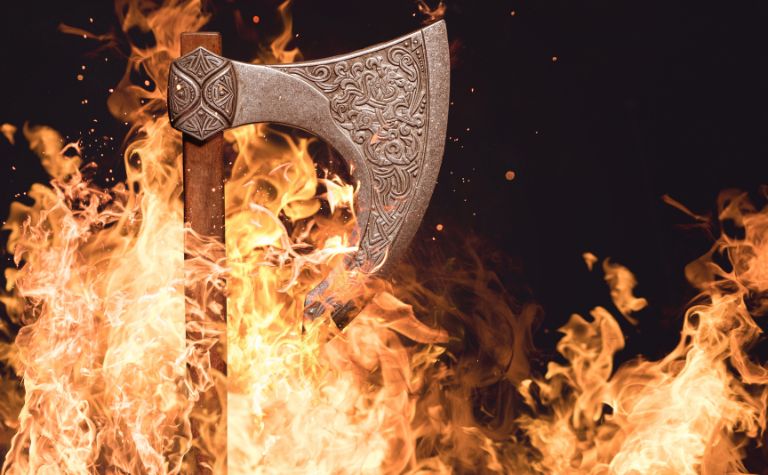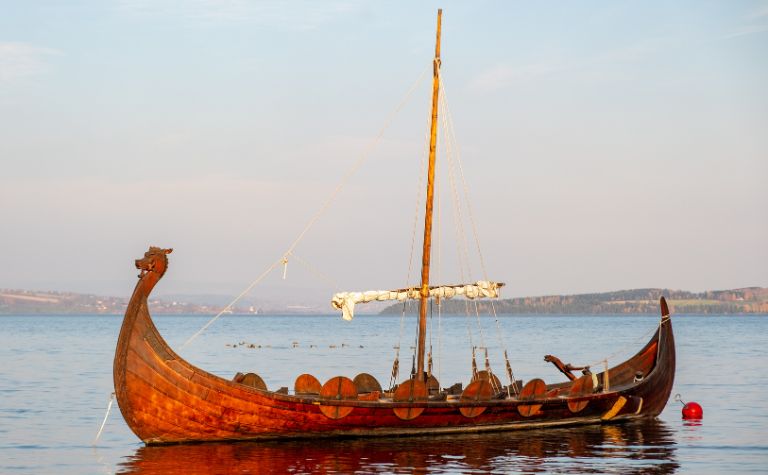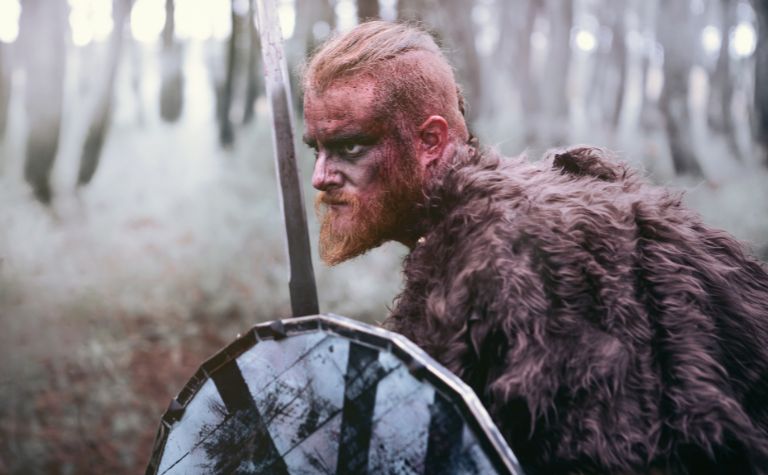Immerse yourself in the enchanting world of Norse mythology, where Valhalla stands as a testament to bravery and honor.
This majestic hall, overseen by Odin himself, is the afterlife’s crown jewel, welcoming only the most valorous Viking warriors.
In Norse mythology, Valhalla holds a place of honor and prestige. It’s a majestic, sprawling hall located in Asgard, the domain of the gods.
However, its grandeur isn’t merely architectural. It’s deeply spiritual because Valhalla is where the bravest of Viking warriors hope to find themselves after death.
Who Goes to Valhalla and Why? What do people do there? Does Norse Mythology have a hell? What’s it like? How is Valhalla imagined in popular culture like the Marvel movies?
Keep reading to learn the answers to these questions and others.
Also, see Where Is Valhalla? to learn more.

Who Goes to Valhalla and Why?
According to the ancient sagas and eddas, the Allfather Odin himself resides over this magnificent hall, welcoming the slain warriors, known as the Einherjar, who the Valkyries have chosen on the battlefield.
Valkyries in Norse mythology are divine maidens serving Odin, who select the bravest fallen warriors from the battlefield.
They are then escorted to Valhalla, where their valor continues in the afterlife.
Valkyries symbolize the honor and glory intertwined in the Viking perception of war and death.
What is Valhalla like?
A place of eternal feasting and battle, Valhalla is said to have a roof made of golden shields and is large enough to house the souls of thousands upon thousands of warriors.
Each day in Valhalla is a celebration of valor and bravery.
The Einherjar engage in fierce combat during the day, honing their skills for the ultimate battle during Ragnarok – the prophesied end of the world.
Yet no matter how deadly the daily skirmishes, they find themselves whole and healed by evening.
And then the feasting begins, with the warriors regaling each other with tales of courage, dining on the inexhaustible boar Sæhrímnir, and partaking of mead provided by the she-goat Heidrun.
Valhalla represents the very essence of the Viking spirit: a place where courage, valor, and the warrior ethos are celebrated for all eternity.
It’s both a destination and a journey, a testament to a life lived fearlessly and with honor.
What is Ragnarok in Norse mythology?
Ragnarok, steeped in the rich lore of Norse mythology, signifies the end of the world, a cataclysmic event leading to both destruction and rebirth.
It paints a dramatic picture of an epic final battle involving revered gods like Odin and Thor, their nemesis giants, and even the terrifying world-serpent, Jörmungandr.
According to prophecy, this apocalyptic event culminates in the earth sinking into the sea, only to re-emerge renewed and fertile, ushering in a fresh start for those who survive.
As with all mythology, Ragnarok is more than a story; it’s a symbol, encapsulating themes of cyclicality, transformation, and renewal.

Does Norse Mythology Have a Hell?
In Norse mythology, if Valhalla is seen as the hall of honor for the bravest warriors, its counterpoint could be considered Hel or Helheim.
Hel is the realm presided over by the goddess Hel, daughter of Loki. It’s a gloomy, cold realm reserved for those who didn’t die in battle, instead succumbing to old age or disease.
In essence, Hel stands as a stark contrast to the glory and endless feasting of Valhalla, embodying instead a quieter, somber afterlife.
| Comparison Aspect | Valhalla | Hel/Helheim |
|---|---|---|
| Meaning | “Hall of the slain” | “Hidden,” referring to its location underground |
| Ruler | Odin, the Allfather | Hel, the goddess, Loki’s daughter |
| Inhabitants | Brave warriors who died in battle | Those who died of illness or old age |
| Lifestyle | Eternal feasting and battles | Somber and quiet |
| Destiny | Preparing for Ragnarok | Rest and repose |
| Environment | Majestic hall, vibrant and warm | Cold, dark, and gloomy |
Who is Hel in Norse mythology?
Hel is the goddess who presides over the eponymous realm of Hel, often referred to as Helheim, the realm of the dead.
Hel is often depicted as a woman of dual nature – half alive, half dead – a symbol representing her unique role straddling life and death.
The daughter of the trickster god Loki and the giantess Angrboda, Hel is part of a fascinating yet fearsome triad of monstrous siblings, including the wolf Fenrir and the world serpent, Jörmungandr.
Assigned by Odin himself to govern the realm of those who died not in battle (those who instead succumbed to natural causes like illness or old age), Hel’s dominion is described as a gloomy, desolate place, far removed from the golden warmth of Valhalla.
Yet, she rules with due authority, a somber queen in her quiet kingdom.
Hel’s character is as complex as it is chilling, and her role underpins the Norse understanding of life, death, and the fragile boundary that lies between.

How is Valhalla Imagined in Popular Culture?
The concept of Valhalla has seeped into various aspects of popular culture, influencing literature, cinema, video games, and more, mirroring our fascination with Norse mythology.
In literature, for example, the concept of Valhalla is used in various fantasy novels to represent a warrior’s paradise, such as in Rick Riordan’s Magnus Chase series, where the main character finds himself in a modern-day interpretation of this mythical hall.
Cinema and television have also embraced the allure of Valhalla.
The historical drama series “Vikings” features Valhalla as a key aspect of Viking beliefs. Similarly, in the Marvel Cinematic Universe, Asgard (home of Valhalla) plays a central role, with characters like Thor and Odin.
Video games, too, tap into this rich vein of mythology.
The popular game “God of War” delves into Norse cosmology, including Valhalla, while “Assassin’s Creed Valhalla” uses it in its title and central theme, providing a rich, immersive Viking experience.
Music and art are not left untouched. The Swedish power metal band Sabaton has a song called “Valhalla,” and numerous artworks inspired by Norse mythology feature Valhalla.
Thus, Valhalla’s presence permeates popular culture, an enduring testament to our enduring fascination with the bravery, honor, and mystique of the ancient Norse warriors.
How is Valhalla imagined in Marvel movies?
In the Marvel Cinematic Universe (MCU), Valhalla is more subtly depicted, but the overarching Norse mythology plays a significant role, particularly in the “Thor” franchise.
The MCU’s Asgard, home of Thor and Odin, essentially incorporates the concept of Valhalla as part of its heavenly and grand realm.
Asgard is portrayed as a place of glory and honor, drawing parallels to the mythological Valhalla.
Valhalla is also indirectly referenced through the character of Odin. As the ruler of Asgard, his status mirrors his role as the overseer of Valhalla in Norse mythology.
The Asgardians, much like the Einherjar in the ancient sagas, are depicted as brave warriors who aren’t afraid of death, holding the belief of ending up in a glorious afterlife reminiscent of Valhalla.
It’s also worth mentioning that the MCU includes the Valkyries, a key part of the Valhalla narrative.
The character Valkyrie, introduced in “Thor: Ragnarok,” was a warrior of the legendary Asgardian group of female fighters who once brought the souls of the worthy to Valhalla.
Their inclusion further roots the storylines within Norse mythology.
It’s important to note, however, that the MCU utilizes creative liberties and is not a strict adaptation of Norse mythology.
The depiction of Asgard and its elements, while inspired by myths, is ultimately shaped to fit the narrative needs of the franchise’s diverse, expansive storytelling.
